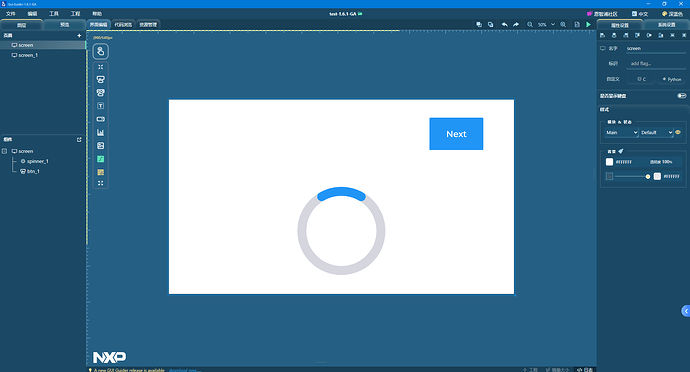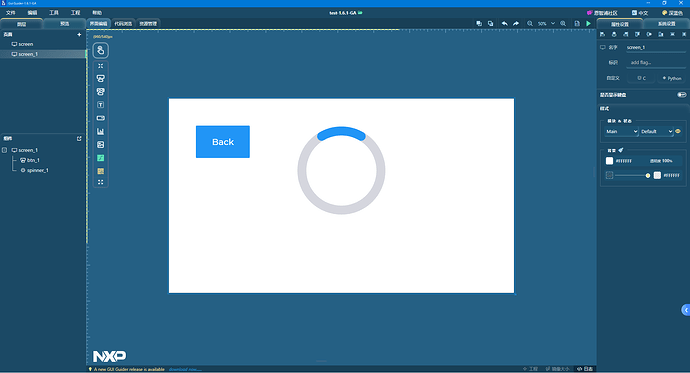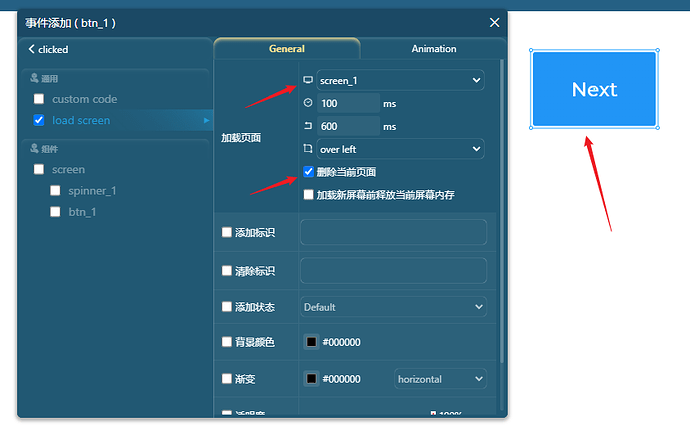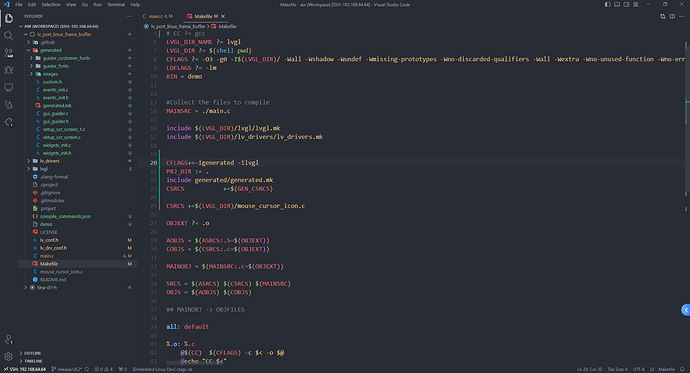博客链接:
pomin.top
界面设计
使用 NXP 的 GUI Guider 软件来对界面进行设计,这里设计了一个简单界面,两个页面可以通过按键来进入、返回
设置 Next、Back 两个按键的事件为点击按键后加载到另一个界面
然后点击生成代码即可,对于生成的代码中,查看工程目录
其中 generated 是生成的代码,lvgl-simulator 是 GUI Guider 模拟器的入口代码,打开lvgl-simulator/main.c 进行查看,可以看到加载生成的界面和事件代码只需要:
- 一个全局变量 lv_ui guider_ui;
- setup_ui(&guider_ui); 载入界面和事件
- custom_init(&guider_ui); 自定义代码,这里没用到
lv_ui guider_ui;
int main(int argc, char ** argv)
{
(void) argc; /*Unused*/
(void) argv; /*Unused*/
/*Initialize LittlevGL*/
lv_init();
/*Initialize the HAL (display, input devices, tick) for LittlevGL*/
hal_init();
/*Create a GUI-Guider app */
setup_ui(&guider_ui);
custom_init(&guider_ui);
while(1) {
/* Periodically call the lv_task handler.
* It could be done in a timer interrupt or an OS task too.*/
lv_task_handler();
#if LV_USE_VIDEO
video_play(&guider_ui);
#endif
usleep(5 * 1000);
}
return 0;
}
然后把生成的这些代码复制到 Linux 的工程下面,在 Makefile 中添加如下代码,把生成代码的 generated.mk 给加入进来
CFLAGS+=-Igenerated -Ilvgl
PRJ_DIR := .
include generated/generated.mk
CSRCS +=$(GEN_CSRCS)
此时 HMI 的事件驱动已经适配好了,下面要做的就是使用 lvgl 的输入设备驱动框架来注册一个真实输入设备,这里也就是红外遥控器上面的两个按键
红外按键输入事件
在前文中,已经知道了红外接收头对应的输入为 event1,在 lvgl 的输入设备框架中注册为两个 button 按键,绑定两个红外按键到 lvgl 的两个触摸坐标 (200, 200), (1500, 150),对于初始化按键的代码片段如下
void lvgl_btn_init(void)
{
/*------------------
* Button
* -----------------*/
/*Initialize your button if you have*/
button_init();
static lv_indev_drv_t indev_drv;
/*Register a button input device*/
lv_indev_drv_init(&indev_drv);
indev_drv.type = LV_INDEV_TYPE_BUTTON;
indev_drv.read_cb = button_read;
indev_button = lv_indev_drv_register(&indev_drv);
/*Assign buttons to points on the screen*/
static const lv_point_t btn_points[2] = {
{200, 200}, /*Button 0 -> x:10; y:10*/
{1500, 150}, /*Button 1 -> x:40; y:100*/
};
lv_indev_set_button_points(indev_button, btn_points);
}
然后再 main 函数中调用 lvgl_btn_init 来完成按键的初始化即可,最终的 main.c 代码如下,因为红外按键按下的时候会连续的发信号,为了避免按下松开太快,实现的是红外按键按下时界面按键按下,等待一段时间后界面按键松开,红外按键松开时无操作的逻辑
#include "lvgl/lvgl.h"
#include "lv_drivers/display/sunxifb.h"
#include "lvgl/demos/lv_demos.h"
#include <unistd.h>
#include <time.h>
#include <sys/time.h>
#include <stdlib.h>
#include <stdio.h>
#include "gui_guider.h"
#include <fcntl.h>
#include <linux/input.h>
lv_ui guider_ui;
static void button_init(void);
static void button_read(lv_indev_drv_t * indev_drv, lv_indev_data_t * data);
static int8_t button_get_pressed_id(void);
static bool button_is_pressed(uint8_t id);
lv_indev_t * indev_button;
int fd_ir;
const char *pDevice = "/dev/input/event1";
uint16_t sw_page_timeout[2];
/*------------------
* Button
* -----------------*/
/*Initialize your buttons*/
static void button_init(void)
{
/*Your code comes here*/
fd_ir = open(pDevice, O_RDWR | O_NONBLOCK);
if(fd_ir == -1)
{
printf("ERROR Opening %s\n", pDevice);
return;
}
}
/*Will be called by the library to read the button*/
static void button_read(lv_indev_drv_t * indev_drv, lv_indev_data_t * data)
{
static uint8_t last_btn = 0;
/*Get the pressed button's ID*/
int8_t btn_act = button_get_pressed_id();
if(btn_act >= 0) {
data->state = LV_INDEV_STATE_PR;
last_btn = btn_act;
}
else {
data->state = LV_INDEV_STATE_REL;
}
/*Save the last pressed button's ID*/
data->btn_id = last_btn;
}
/*Get ID (0, 1, 2 ..) of the pressed button*/
static int8_t button_get_pressed_id(void)
{
uint8_t i;
/*Check to buttons see which is being pressed (assume there are 2 buttons)*/
for(i = 0; i < 2; i++) {
/*Return the pressed button's ID*/
if(button_is_pressed(i)) {
return i;
}
}
/*No button pressed*/
return -1;
}
/*Test if `id` button is pressed or not*/
static bool button_is_pressed(uint8_t id)
{
/*Your code comes here*/
return !!sw_page_timeout[id];
}
void lvgl_btn_init(void)
{
/*------------------
* Button
* -----------------*/
/*Initialize your button if you have*/
button_init();
static lv_indev_drv_t indev_drv;
/*Register a button input device*/
lv_indev_drv_init(&indev_drv);
indev_drv.type = LV_INDEV_TYPE_BUTTON;
indev_drv.read_cb = button_read;
indev_button = lv_indev_drv_register(&indev_drv);
/*Assign buttons to points on the screen*/
static const lv_point_t btn_points[2] = {
{200, 200}, /*Button 0 -> x:10; y:10*/
{1500, 150}, /*Button 1 -> x:40; y:100*/
};
lv_indev_set_button_points(indev_button, btn_points);
}
int main(int argc, char *argv[])
{
/*LittlevGL init*/
lv_init();
uint32_t rotated = LV_DISP_ROT_NONE;
/*Linux frame buffer device init*/
sunxifb_init(rotated);
/*A buffer for LittlevGL to draw the screen's content*/
static uint32_t width, height;
sunxifb_get_sizes(&width, &height);
static lv_color_t *buf;
buf = (lv_color_t*) malloc(width * height * sizeof (lv_color_t));
if (buf == NULL) {
sunxifb_exit();
printf("malloc draw buffer fail\n");
return 0;
}
/*Initialize a descriptor for the buffer*/
static lv_disp_draw_buf_t disp_buf;
lv_disp_draw_buf_init(&disp_buf, buf, NULL, width * height);
/*Initialize and register a display driver*/
static lv_disp_drv_t disp_drv;
lv_disp_drv_init(&disp_drv);
disp_drv.draw_buf = &disp_buf;
disp_drv.flush_cb = sunxifb_flush;
disp_drv.hor_res = width;
disp_drv.ver_res = height;
disp_drv.rotated = rotated;
lv_disp_drv_register(&disp_drv);
lvgl_btn_init();
int ret;
struct input_event ev_ir;
setup_ui(&guider_ui);
// lv_demo_benchmark();
/*Handle LitlevGL tasks (tickless mode)*/
while(1) {
lv_task_handler();
memset(&ev_ir, 0, sizeof(struct input_event));
ret = read(fd_ir, &ev_ir, sizeof(struct input_event));
if(ret == sizeof(struct input_event))
{
if(ev_ir.type == 4 && ev_ir.code == 4)
{
if(ev_ir.value == 0x44) {
if(sw_page_timeout[0] == 0) {
printf("key 0 pressed\n");
sw_page_timeout[0] = 1;
}
}
if(ev_ir.value == 0x40) {
if(sw_page_timeout[1] == 0) {
printf("key 1 pressed\n");
sw_page_timeout[1] = 1;
}
}
}
}
if(sw_page_timeout[0] > 1000) {
printf("key 0 releaseed\n");
sw_page_timeout[0] = 0;
}
if(sw_page_timeout[1] > 1000) {
printf("key 1 releaseed\n");
sw_page_timeout[1] = 0;
}
if (sw_page_timeout[0] > 0) sw_page_timeout[0]++;
if (sw_page_timeout[1] > 0) sw_page_timeout[1]++;
usleep(100);
}
/*free(buf);*/
/*sunxifb_exit();*/
return 0;
}
/*Set in lv_conf.h as `LV_TICK_CUSTOM_SYS_TIME_EXPR`*/
uint32_t custom_tick_get(void)
{
static uint64_t start_ms = 0;
if(start_ms == 0) {
struct timeval tv_start;
gettimeofday(&tv_start, NULL);
start_ms = (tv_start.tv_sec * 1000000 + tv_start.tv_usec) / 1000;
}
struct timeval tv_now;
gettimeofday(&tv_now, NULL);
uint64_t now_ms;
now_ms = (tv_now.tv_sec * 1000000 + tv_now.tv_usec) / 1000;
uint32_t time_ms = now_ms - start_ms;
return time_ms;
}
烧录测试
编译一下然后用 adb 传到板子上面
make -j99
adb push demo /
测试现象,用红外遥控器可以切换页面





